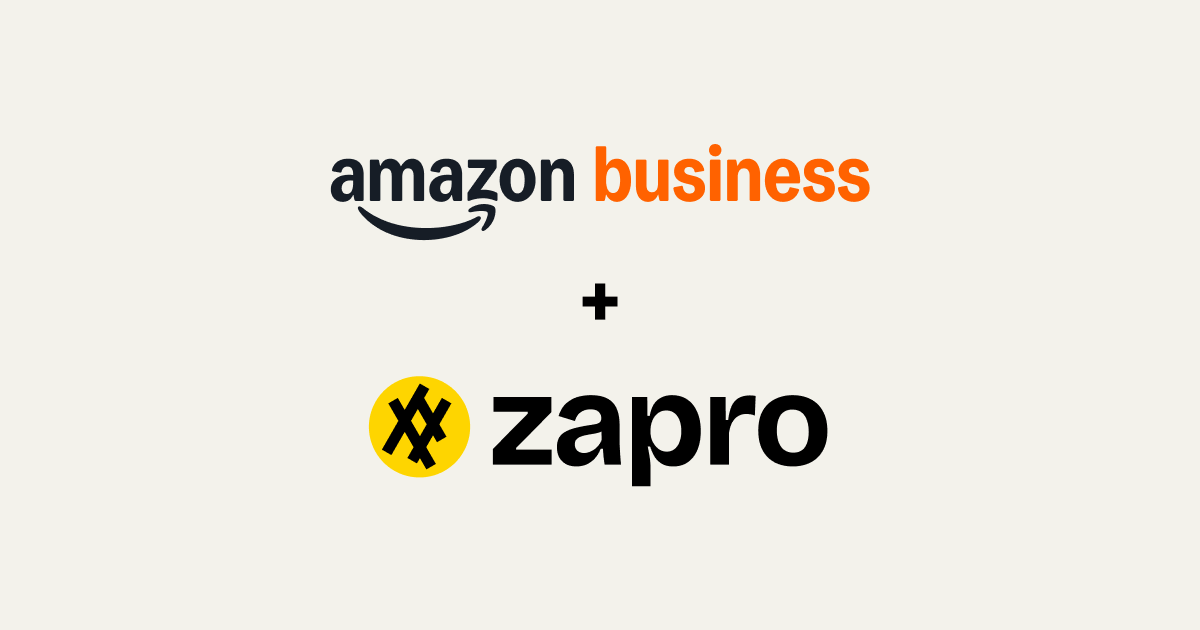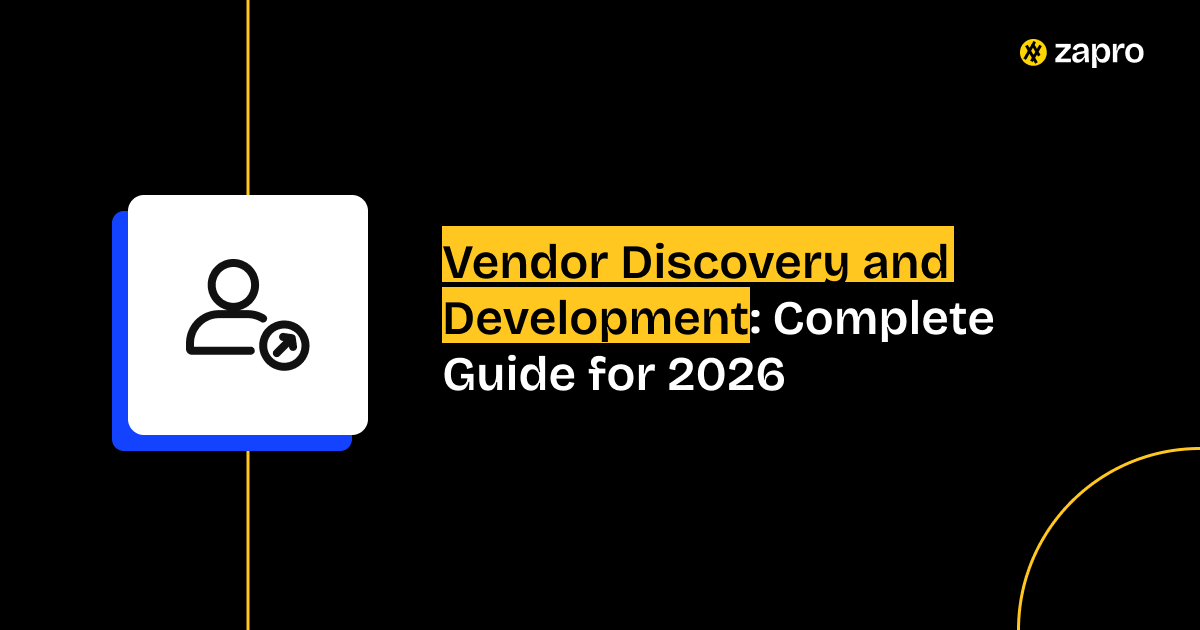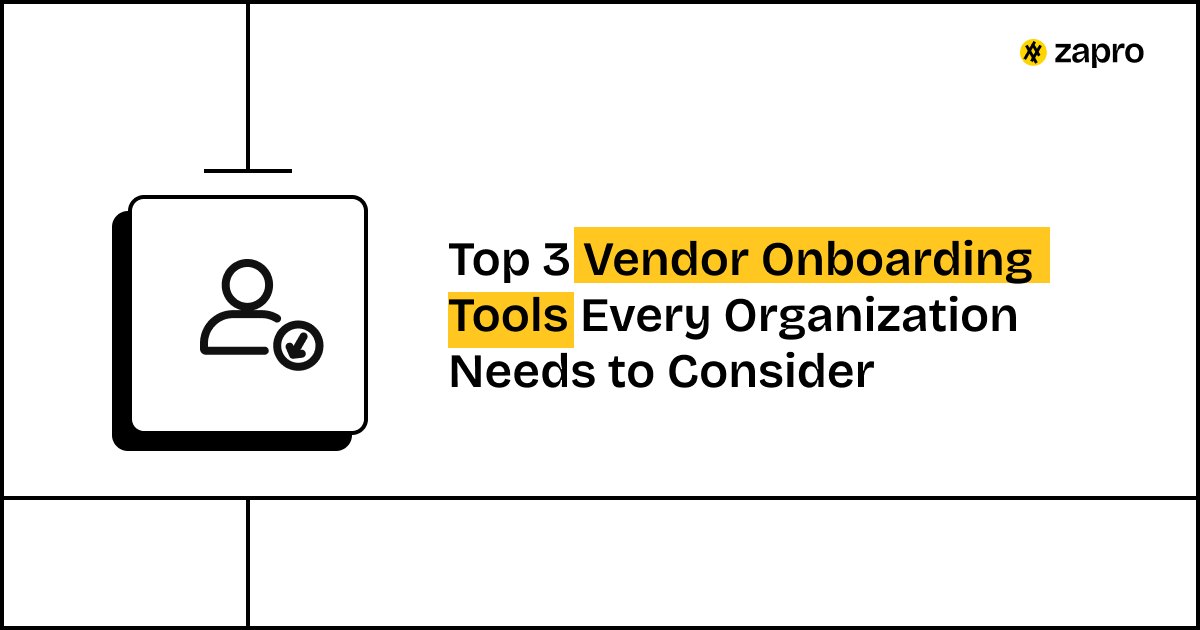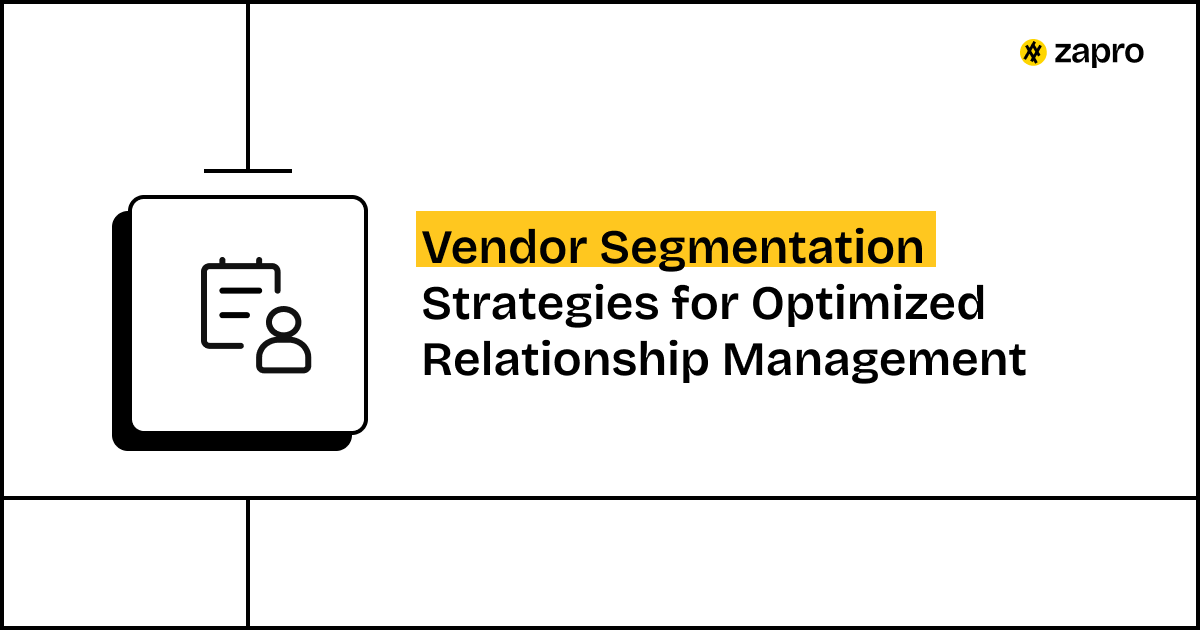The modern business environment is nothing but a web of complicated relationships. For a company to thrive, it depends on a network of suppliers and partners that provide everything from raw materials to essential software services. But obtaining these partners is not as simple as a quick search. The traditional procurement landscape is riddled with problems ranging from fragmented data and manual processes to an ever-increasing list of risks. In 2025, as AI and automation are revolutionizing every sector, the archaic methods of vendor locating and management have become obsolete.
A complete manual of sourcing and vendor relationship building is what this guide is. Just imagine we are talking about the main differences between vendor discovery and vendor development as well as discussing the essential part of the procurement roadmap and furthermore explaining how technology in supply chain is making the businesses uplift their implementation pattern.
What Is Vendor Discovery?
Basically, vendor discovery is the process of one-by-one identifying, realizing, and shortlisting the most probable suppliers and partners. It is the “hunting” period of procurement, where an organization gets to look for new vendors management that can meet a certain need, solve a problem, or simply make the supply chain better. It is certainly not a walk in the park; it calls for a deliberate technique in market studies, sourcing, and first screening in order to develop a strong pipeline of qualified candidates.
Organizations need a precise vendor discovery process. A new approach that you should consider implementing for more reasons than just those mentioned. Initially, you get to step away from the comfort of familiar relationships, which might lead you to miss out on opportunities. Secondly, it acts as a risk mitigation strategy that is proactive. Just by having several candidates for suppliers as opposed to one you solve the problem of supply chain disruption when stock is exhausted.
What Is Vendor Development?
On the contrary, discovery aims to expand the list of partners, while vendor development is centred on building up the existing ones. The vendor development concept revolves around a long-term plan, which aims at raising the competence level of the current provider. That may entail training, streamlining of processes, sharing of knowledge, and co-investment to help a supplier reach your quality standards, lower their costs, and become a more dependable partner.
Not so different from the first one, the growth process is very crucial as a matter of fact. The result of supplier development is the establishment of a sustainable, Frugal, and highly innovative supply chain. It’s a joint effort that changes from simple economic exchanges to alliance-based relations. The process of vendor development makes the relationship evolve from transactional to strategic, a win-win situation.
Vendor Discovery vs. Vendor Development: Key Differences
While these two concepts are often discussed together, they serve very different functions in the procurement lifecycle.
| Feature | Vendor Discovery | Vendor Development |
| Primary Goal | To find and qualify new vendors. | To improve the performance of existing vendors. |
| Time Horizon | Short-term to medium-term (project-based). | Long-term and continuous. |
| Activity | Research, sourcing, screening, due diligence. | Collaboration, training, audits, performance improvement plans. |
| Outcome | A list of potential suppliers for a specific need. | Improved supplier performance, increased reliability, lower costs. |
Effective procurement software requires a mastery of both. Vendor discovery ensures you have a continuous flow of high-quality potential partners, while vendor development strengthens the relationships you’ve already built.
The Strategic Need for Effective Vendor Discovery
Effective vendor discovery is not just a tactical activity any more in today’s fast-moving market – it is a strategic imperative.
Market Pressures Driving Vendor Discovery
The global market is more dynamic and competitive than ever. Technologies, consumer demands, and economic situations are all changing rapidly.
Businesses need to be agile to survive these changes. The process of vendor development will open the door to suppliers who are ready to match these changes. Relying on traditional vendors may cause you to be out of the game due to the sudden market changes and the unexpected innovation of your rivals.
Risk Mitigation and Supply Chain Resilience
The recent global events have made it clear how single-source supply chains are vulnerable. A effective vendor discovery process will help you find other suppliers who are in a different place or operate differently. By diversifying your network with ediscovery vendors and others, you can have the reassurance of an ongoing business and also lower the risks associated with political instability, natural disasters, or even sudden disruptions.
Innovation and Competitive Advantage
The vendors that you are dealing with are not just the providers of the products; they are the origin of innovation. With the new and agile partners you find along the way, your business will become competitive at most. Vendor development comes from the intention of collaborating on answer, innovating, and offering new points of view to the business.

Organizations with mature supplier management programs reduce supply chain disruptions by 50% and improve cost efficiency by 20%.
– Forrester Research, The State of Supplier Management
Challenges in Vendor Discovery & Development
Vendor discovery and vendor development are complex processes that come with a lot of challenges.
Difficulty in identifying reliable vendors
Successful sourcing is not merely about finding a vendor with a low price; it involves evaluating a vendor’s capabilities, financials, product quality, and other non-price-related criteria, which require significant amounts of data and extensive analysis.
Although the benefits are obvious, the transformation is still facing some difficulties. The uncertainty of the most reliable vendors to overcome the vetting process of a new vendor is one of the hardest parts. Getting true, recent financial health, good performance, and compliance records of a company are the key problems of the whole process.
High evaluation cost
The traditional due diligence process is basically sending out RFPs, interviewing the staff, and doing on-site visits. The procedure is very time-consuming and quite expensive.
Compliance and Risk Management
The job of continual updating the set of regulations to be complied with (such as GDPR), and ensuring vendor compliance is particularly challenging and risky when the supply chain is spread over the globe.
Fragmented vendor communication
Without a centralized platform, communication with potential and existing vendors can become a chaotic mess of emails, phone calls, and different documents, leading to errors and delays.
Learn about vendor management tools.
The Vendor Discovery Process: A Step-by-Step Guide
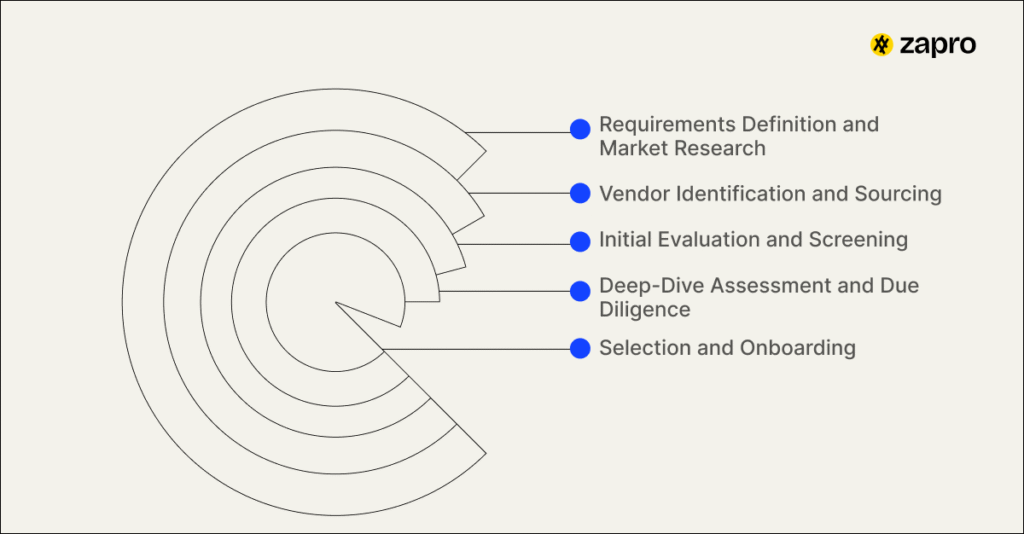
A successfully accomplished vendor discovery process is usually organized around a well-thought-out and methodical plan. You can find below a five-phase guide to mastering it.
Phase 1: Requirements Definition and Market Research
You’re still pretty far from the vendors that are the best fit for your company. You are tasked with defining your needs in this phase, which involves:
- Define the project’s scope, budget, and timeline clearly.
- Identify the necessary goods, services, or skills.
- Executing market research to draw a comprehensive supplier landscape by finding key players, emerging trends, and pricing.
Phase 2: Vendor Identification and Sourcing
This is the “discovery” part. Your potential partners can be found through the following multiple channels:
- Digital Sourcing: Employing online marketplaces, professional networks, and industry directories.
- Referrals: Profiting from your professional network’s connections to get referrals.
- Industry Events: Going to conferences and trade fairs to get in touch with new vendors.
- Search: Utilizing search engines to locate companies that specialize in your required services.
Phase 3: Initial Evaluation and Screening
Once you have a list of potential vendors, you need to narrow it down. This phase involves:
- Inquire basic information by means of a Request for Information (RFI) distribution (RFI).
- Scrutinize the websites, case studies, and customer testimonials of vendors.
- Conducting the first part of the financial stability check and announcing the company’s reputation in the industry.
Phase 4: Deep-Dive Assessment and Due Diligence
When the situation calls for it, you get real. It’s a thorough review and due diligence that follows up for your shortlisted candidates, among which you’ll be:
- How to harness the power of a snapshot Request for Proposals (RFP) to access a wide array of distinct capabilities.
- Interviewing and a one-on-one system are used for presentations.
- Operational risk assessment, for example, by cybersecurity and compliance checks activities.
- Checking up on the people you have been referred to and the info concerning their past perks.
Phase 5: Selection and Onboarding
A final decision after weighing all the candidates, a contract negotiated, and a new vendor onboarded formally, all of this is done after a thorough evaluation. You then become their development process supervisor as you oversee their induction into your standard operating procedures and workflows
Learn more about vendor management software.
Smart Procurement Teams Choose Zapro

Technology’s Role in Modern Vendor Discovery
The tedious and disjointed nature of traditional procurement is on the brink of becoming a thing of the past. It infuses the entire procurement activity with energy and fluidity, and this is exactly what technology is: not only a simple tool, but also the very principle.
AI and Machine Learning Applications
AI is the game changer as far as the vendor discovery process is concerned, and it’s not only that, but as well a smarter and faster process.
- AI-powered supplier matching: How AI can automatically prepare a profile to meet your expectations and quickly find the most suitable suppliers from a very large collection of suppliers’ data, basing on that profile. The AI doesn’t merely look for matching keywords, but it tries to comprehend your ideas from a broader point of view.
- Automated vendor screening and risk assessment: AI is capable of handling a massive number of vendor data points screening tasks through automation, and at the same time is able to carry out risk assessments. It is able to collect information from different sources, for example, it could be from news articles or financial reports, and then uses the information to define the vendor’s risk profile in real time. This is helpful for e-discovery vendors who deal with sensitive data most of the time only.
Digital Platforms and Vendor Networks
Instead of browsing through various fragmented sites, businesses are now leveraging digital platforms that are centralized and a part of vendor networks.
- Digital supplier networks and marketplaces: These platforms serve as a single, most reliable source for businesses to discover and connect with qualified vendors. Simultaneously, they allow viewing vendor profiles, certifications, and performance data in a standardized way.
Data Analytics and Predictive Insights
Data is your most valuable asset in procurement.
- Predictive analytics for supplier performance: The analysis of historical performance data enables you to foresee the vendor-related issues that may occur in the future hence, you can prevent the problems before the vendors are even aware of them. Thus, you are able to avoid troubles and assure a supply chain that is less vulnerable and stronger in this regard.
- Integration with existing procurement systems: The modern platforms can be easily and automatically integrated with your ERP, and all accounting and other administrative systems thereby, all the data being consistent and up to date.
Industry-Specific Vendor Discovery Considerations
The process of changing an old vendor for a new one is not that way for all. The different industries have different needs.
Manufacturing and Production
- Content Focus: Besides quality standards (ISO certifications), the reliability of the supply chain and the geographical aspects are also very important. The vendor development process in manufacturing is, most likely, through the implementation of the joint quality assurance and continuous improvement programs.
Technology and Software Services
- Content Focus: Along with cybersecurity, data privacy (GDPR, CCPA compliance), being a vendor of good use to the market through innovation is the most important thing. The vendor development process here typically includes jointly worked product roadmaps and technical collaboration.
Professional Services
- Content Focus: A vendor’s reputation, case studies, and past performance are among the most important things. The process of vetting may be more qualitative concentrating on expertise and cultural fit.
Healthcare and Pharmaceuticals
- Content Focus: Strict regulatory compliance (FDA), data security (HIPAA), and a stern emphasis on quality control. The necessity for vendor development is exceptionally high to assure that the vendor can reach stringent regulatory and quality standard levels.
Measuring Vendor Discovery Success
How do you know if your vendor discovery and vendor development are successful? By tracking key performance indicators (KPIs).
- Time-to-source new vendors: How long is it from the moment you figure out a need till a contract is signed? A shorter time shows a more effective process.
- Quality of vendor pipeline: Are your vendors of high quality? The percentage of vendors who pass through each step of your evaluation process can be measured.
- Cost savings achieved: Are the new vendors you contracted helping you save money by providing better prices or more efficient services?
- Risk reduction metrics: Are your new vendors lowering financial or compliance risks related to which you are unaware of?
- Supplier diversity improvements: Are you managing to make your supplier base more diversified? It is a major metric of contemporary businesses.
- Innovation pipeline from new vendors: Are the new vendors coming up with inventions, products, or services that give you a competitive edge?
Best Practices for Vendor Discovery & Development in 2025
- Use technology to automate research: Manual searches should be stopped. GPT and online marketplaces are the type of platform you would put to work if you wanted to fast-track the discovery and pre-screening of your next vendor.
- Build transparent vendor scorecards: Apply a universal method of judging vendors against your own set standards. Doing so guarantees impartiality while at the same time cutting down the possibility of prejudice.
- Focus on collaboration and continuous improvement: The vendor development process is a partnership. Work with your vendors to improve their performance and capabilities.
- Integrate vendor data into supply chain planning: The data you collect during discovery and development should inform your entire supply chain strategy, from forecasting to risk management.
How Zapro Simplifies Vendor Discovery & Development
Zapro is the all-in-one platform built to simplify vendor discovery and vendor development work by one step less of the usual manual process. Our solution with AI power converts a complicated, manual process into a more efficient, streamlined, and strategic function.
- Unified platform to discover, assess, and onboard vendors: Zapro gives you the most comprehensive and up-to-date file for all vendor data, removing the need to shift back and forth between numerous tools and spreadsheets.
- Automates compliance checks and qualification: Typically, a platform such as ours would employ AI for perusing vendors’ profiles globally, watchlists, financial data, and regulating databases fully automatically to keep the user always compliant with the enterprise.
- Vendor performance tracking and insights: Our real-time dashboards enable you to monitor supplier’s performance, highlight weak points, and take the initiative, thus managing the relationship in a positive way, which is, in fact, the secret of success for the vendor development process.
- Enables collaboration and long-term growth with vendors: Zapro’s vendor portal offers effortless interaction and document sharing, which are the two vital requirements for establishing a foundation of trust, and therefore, for having long-lasting partnerships.
Conclusion
In the AI era, manually handling vendor discovery and vendor development processes is like holding a liability. The time has come to leave the bygone era behind and use a technology-driven, smart approach. Your supply chain can be transformed into one of the most sustainable, innovative, and competitive by achieving these two key functions.

Your Partner in Strategic Vendor Discovery
Automate vendor discovery, compliance checks, and performance tracking in one platform.
FAQ
1. How long does the typical vendor discovery process take from start to finish?
Usually, the vendor discovery process is between 2 and 6 weeks, the size of which depends on the requirements and the regulations in the industry. It is market research, vendor shortlisting, RFP/RFI cycles, and due diligence checks that takes time. But with automation as well as vendor discovery tools the timeframe is frequently lowered by 40–60%.
2. What’s the difference between strategic vendor development and transactional vendor relationships?
Transactional relationships only concentrate on the short-term, cost-based, and vendor engagements where the latter simply execute orders. On the other hand, strategic vendor development is more thorough — it involves relationship-building with partners that are the source of innovation, co-creation, and long-term business value. Companies that treat vendors as strategic allies receive such returns as better quality, and shared growth besides the already improved reliability.
3. What are the red flags to watch for during vendor evaluation and due diligence?
Common red flags are issues with documentation, low financial stability, lack of compliance certifications, and negative references. Inconsistent communication or resistance to transparency is another indicator of the risk associated with the vendor. Delivery, reliability, and legal exposure challenges can turn out to be bigger issues in the future.
4. How can small businesses compete with large enterprises in attracting top-tier vendors?
Small businesses can still be competitive if they use their strengths such as faster decision-making and stronger collaboration, and can even create niche vendor opportunities. Fair payments and long-term trust are the factors that help to build the reputation of a business. Digital vendor onboarding tools are helpful in making the process smooth and partners friendly.
5. How does Zapro help with vendor discovery?
Zapro simplifies the vendor discovery process by providing a unified platform with the help of AI-powered search, risk scoring, and compliance checks. The manual research is completely done away with because of its direct integration of supplier data into procurement workflows. As a result, organizations can find, assess, and get the right vendors on board much quicker and safer.
Don’t miss our weekly updates
We’ll email you 1-3 times per week—and never share your information.
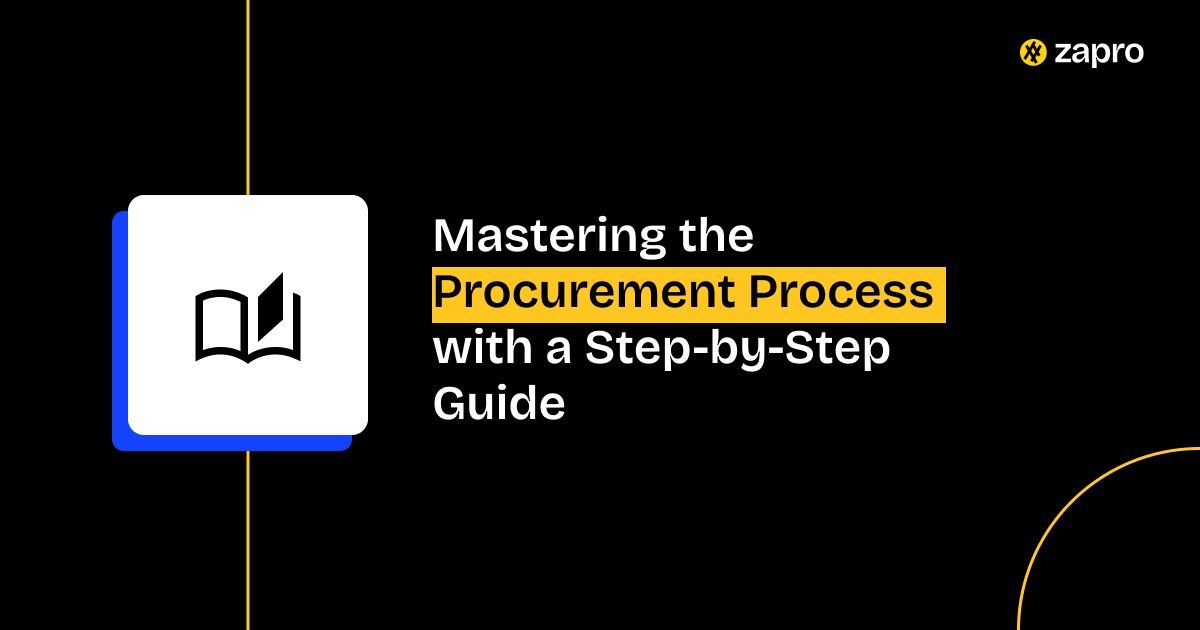
 Healthcare
Healthcare Financial Services
Financial Services Technology
Technology Venture Capitalist
Venture Capitalist Chief Procurement Officer
Chief Procurement Officer Chief Financial Officer
Chief Financial Officer